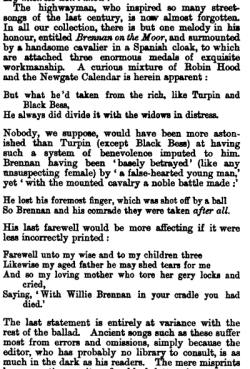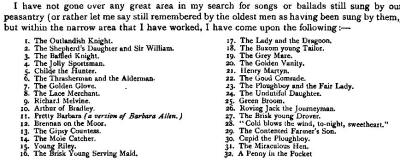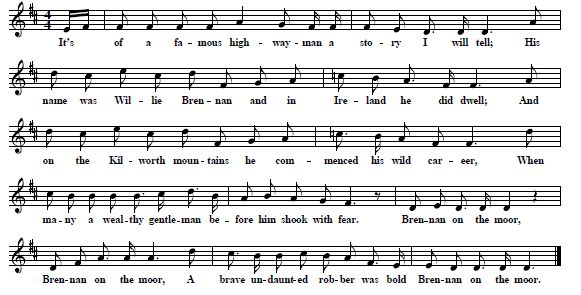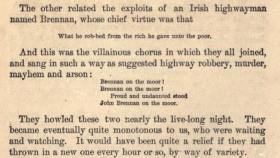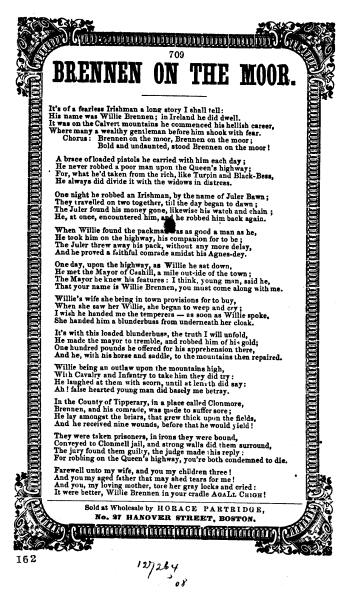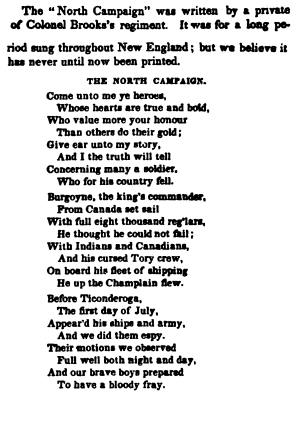"'The History of the Irish Rogues and Rapparees' is at present one of the most popular books amongst the peasantry, and has circulated to an extent that almost seems incredible; nor is it unusual to hear the adventures and escapes of highwaymen and outlaws recited by the lower orders with greatest minuteness, and dwelt on with a surprising fondness" (Thomas Crofton Croker 1824, p. 55, at the Internet Archive). In 1847 John Edward Walsh (p. 84) - a lawyer and at that time reporter in the Court of Chancery - deplored the use of this particular chapbook - John Cosgrave's A Genuine History of the Lives and Actions of the Most Notorious Irish Highwaymen, Tories, and Rapparees (1747) - in so-called hedge-schools and claimed that the children's "integrity and sense of right and wrong was confounded, by proposing the actions of lawless felons as the objects of interest and imitation". The most popular Irish highwayman since the second half of the 19th century was William Brennan who is immortalized in the ballad "Brennan On The Moor". Not much is known about him except a lot of
But the definitive and most influential version surely was the one by the Clancy Brothers who included it in 1961 on The Clancy Brothers and Tommy Makem (Tradition TLP 1042) and on their first Columbia LP A Spontaneous Performance Recording (CL 1648) "Pat learned this song from his father's mother, a tall woman who wore a big, black cloak and hood and was known throughout the neighborhood for her fine singing. Brennan, the bold highwayman, was executed in Clonmel, which is twelve miles from where the Clancys lived [...] Paddy has shortened and adapted the song from the way he learned it, but the heart of this tale of a 'brave and undaunted' highwayman who was ''betrayed by a false-hearted woman' remains intact" (From the liner notes to Tradition TLP 1042). A live version by the Clancys with Tommy Makem from Australian TV 1963 is available at YouTube at the moment and the sheet music for the tune associated with this song can be found both at traditionalmusic.co.uk and The Digital Tradition Database II.The first one to offer some additional information about Willie Brennan's "wild career" was one D. J. Norris who published his findings in an article in the Irish magazine The Shamrock in 1875. It is quoted by Séamus Ó Cáthain in his Irish Life And Lore (p. 12 - 16). But his story sounds a little bit too romantic and unrealistic for my taste. Norris claimed that Brennan was born in "Kilworth some two miles north of Fermoy, county Cork" and that his "father was an affluent farmer by the banks of the famed Blackwater": "One fine morning while still a young man, Willie Brennan was witness to an Irish eviction. His father was dispossessed. His mother was taken from her sick couch and saved from homelessness and want by the generous love and hospitality of the people. But her death followed quickly upon the event and thenceforward Willie Brennan was an outlaw, resolved to protect the poor from the despotism of petty tyrants. He took to his native hills and in a short space of time had surrounded himself with a trusty gang of men injured as he had been and desperate as he was himself. No oath it is said bound them together but they were simply in league to defend the helpess peasantry against the persecutions of the vampire anstocracy in Ireland. Few names evoked more popularity than that of the rapparee Captain Willie Brennan. [...] His exploits were all of a chivalrous character and he had a great aversion to the shedding of blood [...] Large rewards were frequently offered by the government for his capture [...] At length, howeyer, he was betrayed. One night, in the depth of winter, he took refuge in a cottage at the foot of Galtee More, whose occupant was a woman of unsettled habits [...] She had been the frequent recipient of Brennan's bounty [...] First she wet the powder in the pan of his blunderbuss and then she crept stealthily forth to acquaint the soldiery that the dauntless outlaw was at their mercy. The troopers came and laid hands upon him while he slept, but nevertheless, Brennan made a gallant struggle for his liberty [...] it was often said that the first blood shed by Willie Brennan was the blood he shed in his last defence. There was no possibility of overpowering the number of his assailants so that he was finally captured and in a brief time, after a routine trial had been gone through, the eventful life of the rapparee Captain Willie Brennan was terminated upon the public scaffold in Clonmel." The Reverend Power in a short article for the Journal of the Waterford and South-East of Ireland Archaeological Society (Vol. 14, 1911, pp. 191/2) noted that William Brennan "was born at Raspberry Hill, a frontier townland of Co. Waterford, on the north bank of the Blackwater" and quotes from an "old newspaper cutting (name of newspaper not recorded)": "Brennan was captured in County Tipperary, and tried and executed in Clonmel Gaol, and that his remains were as usual in those days, handed over to his relatives for interment. There seems to be no doubt that, in common with many others of his class in those troubled times,he was looked on in the light of a popular hero, as the long calvacade, up to two miles in length, that followed his remains to their last resting place in Kilcrumper - midway between Kilworth and Fermoy - testified. His grave is still pointed out beneath a little niche in the only existing wall of the old church of Kilcrumper. I heard the story and many of his wild adventures nearly forty years ago from the lips of an old man who witnessed his funeral. I never could ascertain what first induced him to 'run the outlaws wild career' [...]" According to another story (Dunford 2000, p. 199; see also Healy 1965, p. 120) his "career [...] began lightly": "In his youth Willie was employed as a farm labourer by the Grant family at Kilmurry House, a splendid mansion and estate situated on the Fermoy-Ballyduff road. In all likelihood he would have continued to lead an uneventful life had it not been for the visit of a British army officer . A number of the other servant boys wagered that he dared not to rob the soldier of his gold watch and chain. Willie accepted the wager and gained the watch and chain, but forfeited hisfreedom: as a result of this reckless act, he was forced to flee to the hills". But Cashman (p. 10) notes that a "similar story" was also told about James Freney, a popular highwayman of the 18th century. On the other hand a folk tale recorded in 1934 tells us that Brennan was a former soldier who had deserted from the army (quoted from Seal, p. 75): "Brennan was born in Kilmurry, near Kilworth. He listed in the army and then deserted out of it. They were hunting him around the country day and night". Even the year of his death is not clear. It seems that today 1804 is taken for granted (f. ex by. Seal, p. 72 William Grattan Flood in a letter to The Musical Herald (1.3.1909, p. 71) claimed that "Brennan was alive in 1809" . Clark & Donelly (1993, p. 85, n. 89) mention a "gang led by Edward Brennan in south Tipperary and north Cork in early 1809". In fact two reports from 1809 describe some of the not so chivalrous activities of a robber named Brennan. One is from The Edinburgh Annual Register for 1809 (Vol. 2/2, 1811, p. 44) and the other one can be found in Walker's Hibernian Magazine (Dublin, February 1809, p. 125/6): "Mr. Jackson, of Milgrove, Cork, was stopped in his avenue, by the noted Brennan and four others, who leaped over the hedge, one of who seized his horse by the bridle, and led him back to his house. - Brennan and another went into the house, the rest were stationed in different situations on the outside. Brennan said 'money was all he wanted, that he must have it, and that he would vivit all the other entlemen in the country in like manner.' Mr. Jackson strove to detain the banditti as long as possible, in hope of assistance. - Brennan was impatient, and struck Mr. Jackson with his blunderbuss, and urged him to give up his money. They remained in the house about three quarters of an hour, (during which time near one hundred men colleced about it from the woollen manufactory and neighbourhood) and went off, taking with them about 40 guineas in cash, and two guns. - An express having been early dispatched to Lord Caher, he with great expedition arrived from Caher, a difference of four miles, with a party of dragoons about an quarter of an hour after the robbers had left the house. Brennan and two of his party took took the mountains behind Millgrove, and were pursued and kept in view by about ten persons, but who unfortunately had but one gun, which was twice snapped at Brennan but missed: Brennan and one of his comrades likewise snapped, but the wetness of the day prevented the pieces from going off. - The partys had Brennan still in view, when Lord Caher and the cavalry came up, but a heavy snow falling at the moment , the robbers unfortunately escaped [...] we regret much that his lordship was prevented by the severity of the weather from coming up with the robbers". But the Lord had better luck the next time he tried to catch Brennan as we learn from a report in the Caledonian Mercury on March 18, 1809, at BNA): "Thursday, Lord Cahir, with an armed force, apprehended the notorious Brennan, near Templemore, in the county of Tipperary, together with one of his comrads, a pedlar, who always accompanied him; the pedlar fired several shots, none of which took effect - Brennan made no resistance". This story was told in more detail in an "Extract Of A Letter From Clonmel, March 2" printed in the Morning Post on March 27, 1809 (p. 2, at BNA): "Brennan, and his associate the Pedlar, were taken this day. This daring fellow and his party,last night attacked the centinel at Mr. Jackson's, at Milgrove, fired several shots at him, one of which took away part of the skirts of his coat; the centinel returned the fire, and the guard pursued, but without effect. A Gentleman, who either saw Brennan, or had information of his being in the neighboorhood of Tenvurry this morning, rode to Cahir and informed Lord Cahir of it, who instantly ordered out the garrison, who were joined by most of the town. At the village of Clenmon, which is nearly midway between Tencurry and Cahir Abbey, a close search commenced, and he Pedlar was first discovered in a chimney of a new house, but did not surrender until he ineffectually discharged all his fire-arms. Brennan was at length discovered, about two o'clock this day, by the prod of a soldier's bayonet into a rick of straw, which struck him in the back; and made him spring out, when he was secured - he had nothing on him, except breeches, at the time he was taken". The last we hear about this Brennan and the pedlar is a short note in the Lancaster Gazette, April 8,1809 (p. 2, at BNA): "Brennan and his associate, the Pedlar, after a short trial, have been capitally convicted at the Clonmel Assize". According to a story recounted by Stephen Dunford (p. 205/6) Brennan was not even executed but killed in 1812 when he tried to rob "Mr Jeremiah Connor, a solicitor and friend of Daniel O'Connell": "The year was 1812 and the place a point on the road between Milstreet and Killarney at Lisable. Brennan lay concealed, masked and armed inside the entrance to a quarry [...] As [Connor's] carriage drew close, out sprang Brennan, blunderbuss at the ready [...] Without hesitation the solicitor took from his pocket a purse and flung it to the ground, as if surrendering immediately for fear of violence. As Brennan bent to pick it up, Connor drew a pocket pistol from his overcoat and fired. His aim was true: the ball struck the outlaw. Badly wounded, Brennan dropped his weapon and [...] crawled into the dense underground [...] The following day the dead body of the outlaw Brennan was discovered behind a ditch a short distance from the road. The account comes from no less a source and authority than O'Connell himself who related the incident to his secretary and biographer, O'Neill Daunt. Indeed, when both were journeying together, O'Connell pointed out the exact spot on the road where the outlaw had fallen". In fact this was first told by William O'Neill Daunt in his Personal Recollections Of The Late Daniel O'Connell (Vol. 1, 1848, pp. 106/7) but no exact date is given there and it's not clear w "This is utterly without any foundation in fact. Brennan died by the rope. He was hanged in the town of Clonmel, in or about the year 1808, together with an accomplice, called 'the White Pedlar.' We remember the occasion well. The member for Tipperary, the Hon. Montague Matthew, a brother of the late Lord Landaff, strongly interested himself to procure a remission of his sentence for the convict. It was his belief that he might be effectually reclaimed from his dangerous courses, and render good service to society, by his active exertions as a police officer. The Duke of Richmond was Lord Lieutenant at that time - and, when the county member vehemently pressed his suit, is said to have answered him, 'I will consent to your proposal upon one condition.' 'What is that?" eagerly interposed Mr. Matthew, determined that no trifle should stand between him and the object of his wishes. 'That you,' said the jocose viceroy, 'should be hanged in his stead?'" In 1812 the The Sporting Magazine (p. 294) reported that a highwayman named Brennan had been arrested "some months ago": "When Brennan the noted highwayman was taken in the south of Ireland some months ago curiosity drew numbers to the gaol to see the man loaded with irons who had long been a terror to the country; among others was a banker whose notes at that time were not held in the highest estimation, who assured the prisoner that he was very glad to see him there at last. Brennan looking up replied, 'Ah Sir, I did not expect that from you - indeed I did not; for you well know that when all the country refused your notes - I took them'". This story was also printed in other British newspapers at that time (see for example Northampton Mercury, March 7, 1812 and Liverpool Mercury, March 13, 1812). In 1823 a book with the title The Irish Freebooter, or, Surprising Adventures of Captain "This Brennan was, at this time, the terror of the surrounding country, effecting many robberies with impunity. He was at length, however, taken, about three months after my recontre with him, and was executed in a short time afterwards. He was the most noted robber that had been in Ireland for some years". Interestingly Jackson's Oxford Journal on February 25th, 1804 published a report about the death of the "Irish Rebel Chief" James Corcoran. An outlaw named Brennan was member of his gang: "Corcoran, the Irish Rebel Chief, who has been for a considerable time the terror of the county of Carlow, and for whose apprehension a large reward was offered by Government, has at length terminated his career. The Reverend Mr. Eastwood, of Kilian, in the county of Wexford, having received information that Corcoran and some of his gang were concealed in a house about a mile distant from him, sent a party of twelve yeoman of the Jamestown infantry, under the command of William Ellison, Sergeant in the Ross Guards, who approached the house with his small party in three divisions, and after receiving the fire of rebels, closed on them. Corcoran received a shot through his body, and is since dead. An outlaw of the name of Brennan was wounded, and a noted rebel, J. Fitzpatrick, who had deserted from Hompesch's corps, and went under the name of Hessian, was secured. - A blunderbuss, two muskets, (which had been plundered from some of the Borris infantry) and several pistols, fell into the hands of the Yeomen, who conducted themselves with uncommon steadiness". This story has some surprising parallels to some of the legends about "Brennan On The Moor" although it happened in another county and it was a different Brennan: obviously Corcoran and his men were betrayed by an informer who had alerted Rev. Eastwood about their hiding-place. Then there was a fight with the soldiers and this Brennan was also hurt. But according to a report in Walker's Hibernian Magazine (March 1804, p. 129) he managed to escape. Not at least the other "rebel" mentioned here was a soldier who had deserted from his unit just like Brennan himself according to one of the stories told about him. The "Brennan On The Moor" of the ballad looks like a composite character based on more than one real person who then served as a focal point for floating motives and stories known from other "heroic outlaws". The "real" William Brennan - whoever that was - is indeed very elusive. The only thing we know for sure is that outlaws by the name of Brennan were busy in Southern Ireland at that time: one was executed in 1809 and another one in 1812. III.
To my knowledge there is no evidence that this text was published or even existed before the 1840s. Interestingly neither Thomas Crofton Croker in 1824 nor John Edward Walsh in 1847 mentioned Brennan or a song about him. It seems it was written considerable time - more than 30 years - after his death and it would be worth discussing why this ballad suddenly appeared on broadsides in the 1840s. All modern versions of "Brennan On The Moor" just like the one performed by the Clancy Brothers are derived from this broadside. But they are usually shorter and have less verses and there is one important difference. In the original text Brennan is betrayed by a man while in today's variants the culprit is a "false-hearted woman". In all these broadsides - except the one from the Cuala Press - the "Livart" or "Lilvart" Mountains are the place where Willie Brennan had "commenced his wild career". There are no such mountains in Ireland or at least I couldn't find them. This may be mutilated form of "Kilworth" as in Joyce's version. Or else the writer wasn't sure about Irish geography and has invented some non-existing place. It is obvious that the anonymous writer of this text must have been conversant with other outlaw ballads. In most of the verses common stock motives and formulaic elements (see Seal, p. 4 - 11) known from earlier songs about other highwaymen are recycled. But - as Cazden et al.(p. 414) note correctly - he was also was able to use the "rather sophisticated device of literary reference". In fact the verse about the pedlar refers to a ballad about "Robin Hood And The Bold Pedlar" (s. also Seal, p. 23, 75, Cazden et al. p. 414). The legendary English outlaw Dick Turpin - executed in York in 1739 - is even mentioned by name. The song "Turpin's Valour" (see Logan, pp. 115-121, Chappell 2, pp. 661-663) was published in 1796 in a chapbook and especially the last three verses of that song could have been an inspiration to the writer of "Brennan On The Moor". There are also parallels with "The Croppy Boy" ( Harding B 11(1486)), a song from the Irish rebellion printed since the 1830s : the fight with the cavalry and the betrayal, here by his "first cousin". Not at least the father in this song disavows his son just like the mother in "Brennan". In fact he looks a little bit like a cross between a benevolent robber and the Irish rebel. But in Ireland the stories and songs about highwaymen always had a political undertone as they were also "engaged in a lonely and courageous battle against foreign oppression" (O Cathain, p. 7, see also Seal, p. 78) There is also a Scottish song called "Bold Brannan On The Moor" with a different text. Robert Ford (1901, p. 58) noted
The refrain is the same and the penultimate verse is similar to the last verse of the other text: here it's the father instead of the mother who wishes that Brennan "in his cradle had died". But only two of the six verses are about his adventures as a highwayman who "robbed from the rich, and gave it to the poor". Generally this text is in fact more like the lamentations of and about criminals on their way to their execution that were so popular back then. Interestingly in the first verse "Bold Brannan" states that he had deserted from the army and this complies with the folk tale recorded in 1934 (see Seal, p. 75). Also according to the story in the New York Mirror in 1840 (p. 125) the real Brennan had said that he "never allowed a deserter to pass in custody whom he could set at liberty": "He inquired particularly if I recollected a deserter's having been rescued from a party of our regiment while passing over the mountain, about a month before. And on my replying in the affirmative, he informed me that he was the man who rescued him". So both the song and the real Brennan's concern for the well-being of deserters may serve as additional evidence that he himself was a former soldier who had started his career after deserting from the army. But on the other hand it seems a little strange that there was a ballad about an Irish outlaw in Scotland before there was one in Ireland. It's not impossible, of course. There was at least one report about the Irish Brennan in a Scottish magazine. But Ireland is never mentioned in this song. Maybe it was at first a lament about an original Scottish outlaw by the name of "Brannan" that was later exported to Ireland where it was rewritten as a ballad about their own Brennan. That would explain a lot, especially why the Irish "Brennan On The Moor" appeared on broadsides only in the 1840s so many years after the outlaw's death. Only since the 1860s the song "Brennan On The Moor" is mentioned in the secondary literature. It was first discussed in 1863 in an article about "street songs" in the Chambers In 1869 Ralph Varian published the song in his The Harp of Erin: A Book of Ballad-Poetry and of Native Song (p. 272-274). Interestingly he used as the title: "A Lament On The Execution Of Captain Brennan". It is the first text where Brennan was betrayed not by a "young man" but by a woman as in the story told by Norris in The Shamrock in 1875. The rest of the text is nearly identical to the broadsides, there are only minor discrepancies. But Varian included an additional penultimate verse that I haven't seen in any other English-Irish version, except Tom Kines' (on Folkways FW 03522) who has recorded a variant from Nova Scotia: When Brennan heard his sentence, he made his reply: - In 1889 Folk song collector Sabine Baring-Gould listed "Brennan" as one of the ballads "still sung by our peasantry or [...] still remembered by the oldest men as having been sung by them" (p. vii) and in 1893 he noted it was "sung all around Dartmoor" (SBG/1/2/822). He collected In 1896 Katherine Tynan Hinkson wrote a fascinating article for the New Review about "An Irish Peasant Woman", Hannah Quinn from Cork who knew "many famous ballads now forgotten" (p. 534/5): "There is the song of. Brennan on the Moor which relates the adventures of a famous highwayman, to the Irish peasant mind a mixture of the qualities of a Duval and a Robin Hood. [...] I have a picture in my mind of Mrs. Quinn seated on the ground before a red-hot fire, and searching in the mists of fifty years for some missing verses of Brennan. 'Give me time, give me time,' she would cry, ' and I'll have it.' Then she would mutter over a bit of verse, and brightening up would say: 'I remember there where Brennan's wife drew out the pistol, and the faces of the crowd, all round, and the old women groanin' out - 'Sure my blessin' on her, wasn't she the great woman entirely!' I was a little shaver then, not up to the elbows of the others. Wait, sir, give me time. Or wait till I've a drop taken ! Sure, comin' home along the road at night I do be rememberin' them as plain as prent. An' then the next mornin' they're gone entirely.'" Robert Ford included both the Scottish - with a melody "fixed [...] on paper from the lips of a wandering Orpheus many years ago" - and the English-Irish variants in his Vagabond Songs And Ballads Of Scotland (1901, pp. 56-61) while Cecil Sharp used a version with eight verses for his Folk Songs From Somerset (1904, No. 25, p. 52). In 1909 P. W. Joyce published a tune he had taken "down from a ballad singer in Trim about fifty years ago" and a text with 11 of the 12 verses in his Old Irish Folk Music (pp. 186-7). This may be the earliest dateable version of this song and it is not unreasonable to assume that this could have been the melody originally used for 'Brennan On The Moor' in Ireland.
Other English collectors were successful too: George Gardiner & John Guyer in Portsmouth 1907 (GG/1/15/915 & GG/1/14/890), Vaughn Williams in 1908 (Palmer, No. 15, p. 25, 187) and Anne Geddes Gilchrist in Lancashire 1909 (AGG/3/63c & AGG/8/9, all at The Full English Digital Archive). In Scotland Greig & Duncan (Vol. 2, No. 258, pp. 251-263) collected the Scottish version. One variant (B) is closer to Ford than to the broadside text while the other - by Miss K. Morrice (A) - has some additional lines. The words of those "Folk versions" are always derived from printed sources.. In fact Mr. Whitehead - informant for Anne Geddes Gilchrist (AGG/8/9) - reported that "he and his companions had learned their songs from songbooks". Often they are incomplete and there are only very few noteworthy textual variations. But at least the non-existing "Livart" Mountains were replaced for example by "Limerick" or "Libbery". Interestingly in one version collected by Francis Collinson (COL/4/33, undated, at The Full English) Brennan is transplanted to England: It's of a fearless highwayman a story now I'll tell, In fact Maureen Jolliffe (p. 28) notes "that one Patrick Brennan was convicted of horse-stealing at the Dorset County Assizes sometime towards the close of the eighteenth century, and duly executed". In England "Brennan On The Moor" was often sung to different melodies. This is typical for a song dissipated by broadsides. For example Baring-Gould wrote down three more or less different tunes on one manuscript page (SBG/1/2/822). The version collected by Vaughn Williams had a "tune more usually associated with 'The Tailor In The Tea Chest'" (Palmer, No. 15, p. 25, 187) while Gardi IV."Brennan On The Moor" was known in North America at least since the 1860s and it was first printed in 186 "Then [...] the dolorous interminable lay of 'Bold Brennan On The Moor' (such rhymed histories of highwaymen were and still are surprisingly popular on the prairies) would be chanted slowly and solemnly by some soloist of established reputation".
And he proved a faithful comrade amidst his Agnes-dey. The song was then printed regularly until the turn of the century. Interestingly the versions in the Universal Irish Songbook (P. L. Kenedy, New York 1884, pp. 77/78 ) and in Hyland's Mammouth Hibernian Songster (ca. 1901, p. 137) were taken taken from Varian's Harp Of Erin. Others like those in Manus O'Conor's Irish Come-All-Ye's. A Repository Of Ancient Irish Songs And Ballads (New York 1901, p. 59) and Wehman's Irish Songster (p. 11, around the turn of the century) are clearly based on the song sheet from the 60s as they have retained the error in the fourth verse. The anonymous editor obviously tried to repair it but it still doesn't make much sense: And he proved a faithful comrade amidst his Agnus-dei. But there is one important change in this edited version. While on the early song sheet Brennan still was betrayed by a man - as on the British broadsides - here a "false-hearted young woman" was responsible. In fact in all English and Irish variants except the text in Varian's book the traitor is a man while in all American versions except the song sheet from the 1860s he is replaced by a woman. So this variation seems to be an American specialty added to the song at a later point but maybe at first instigated by Varian's version. It's no wonder that Folklorists in North America also managed to collect versions of "Brennan On The Moor" from oral tradition (see Traditional Ballad Index and Roud Index: No. 476) . The song was known from Virginia to Nova Scotia and from Utah to Wisconsin (see The Wisconsin Folk Song Collection, 000064.bib) and Pennsylvania. Most of the variants from oral tradition are clearly derived - directly or indirectly - from printed sources and - just like in England - there are very few variations except the changing of names. A version from Virginia collected by Cecil Sharp in 1918 (Sharp 1932, pp. 170/1) is a typical example: here Willie Brennan starts his career "on the Culloden Mountains" and the pedlar's name is "Joel Spoern". Otherwise the informant only remembered 6 verses so it's more a fragment than
A version from Oregon recorded in 1938 by Blaine Stubblefield for the Library of Congress was included by John & Alan Lomax in Our Singing Country (1941, p. 317). This is a more or less complete performance with 11 of the 12 original verses. Only one version I know of offers more interesting variations. John Quincy Wolf recorded a performance by Neal Morris in Timbo, Arkansas in 1959 (available at the Wolf Folklore Collection). Here Willie Brennan and the Pedlar "Julius Vaughan" - clearly derived from the "Juler Bawn" on the song sheet - are pardoned by the Queen and then join Sir Humphrey Gilbert and later John Hawkins to continue "with their robbing/From the Spaniards on the sea". Another indication for the popularity of "Brennan On The Moor" in the USA are a couple of songs that have used its melody and structure. For example Edwin Wolf in his American Song Sheets, Slip Ballads and Poetical Broadsides, 1850-1870 (p. 44, No. 659) lists this song:
"Charlie Quantrell" was collected by John & Alan Lomax in 1938 in Texas (Lomax 1938, p. 144 - 146 , also Lomax 1960, p. 347/8). One of their informants reported that she "had learned this song from my mother, who learned it from her boy friend fifty years ago. He learned it 'out West'". Here Brennan and Ireland is simply replaced by Quantrell and Kansas, most likely a reference to William Quantrill, the notorious bushwacker and pro-confederate guerrilla who was busy raiding in Kansas during the Civil War. Otherwise there are only few variations and the song has absolutely nothing to do with the real Quantrill except that he really had attacked a town called Lamar in Missouri both in 1862 and in 1864. But he wasn't taken prisoner there instead he was killed a year later in Kentucky. It seems this song was very rare. I only know of a variant with some minor discrepancies recorded by Glenn Ohrlin in 1969 (available at The Max Hunter Folk Song Collection) and I'm not sure if this is based on Lomax's version or a taken from an independent source. "Bracey On The Shore" was collected on the Cranberry Islands/Maine in 1926 by Fannie Hardy Eckstorm. It had been written in the 1870s "to the popular tune of 'Brennan on the Moor'" and was "still sung, especially on winter nights when the men are gathered round the stove in the store" (Eckstorm/Smyth, pp. 332-334): It was of a young sea captain, on Cranberry Isles did dwell; [Refrain] He arrived to Cranberry Island and anchored off the Point; [...] The way he's got his living is smuggling tea and gin, More problematic is the relationsh Dichter & Shapiro (p. xxi) date this song as from 1777 and it's not clear if it was published on broadsides at that time. Rufus W. Griswold included it in his Curiosities of American Literature (1843, p. 32) with the title "The North Campaign" and noted that it "was written by a private of Colonel Brooks' regiment. It was for a long period sung throughout New England". If this song was really written shortly after the battle it was surely not derived from "Brennan On The Moor". At that time Willie Brennan was lying in his cradle, hadn't yet started his career as highwayman and the song about him hadn't been written. I think this melody was only borrowed at a later point, maybe by Burl Ives. It should also be noted that the early printed versions from the 19th century didn't include the refrain used by Ives, Nye and Silverman. And of course I must mention Bob Dylan, who was a great admirer of the Clancy Brothers. His "Ramblin' Gamblin' Willie" (1962) is based on their version of "Brennan On The Moor" but here Willie Brennan, the highwayman is turned into Will O'Conley, a gambler (see the complete text at Bobdylan.com): Come around you rovin' gamblers and a story I will tell [...] In the film´No Direction Home, Liam Clancy relates the story of Dylan first presenting the verses to him one day: "I remember meeting him one morning on the street - he lived on Sullivan Street, in Greenwich Village. And I was rushing off to rehearsal, I was getting the subway, we were meeting uptown, and he stopped me in the street and he said, "Hey, man, hey, Liam, wrote a song to 'Brennan On The Moor' last night." He had it... he said, "I wanna sing it for you." Right there in the street, he starts singing this song which went on for about nine or ten verses. I remember saying to him, "You got a fantastic talent, a fantastic imagery, if you could squeeze it all in together and make the songs a bit shorter". [...]" Dylan recorded this song at Columbia Studio A, New York, 24 April 1962 but it was not included on The Freewheelin' Bob Dylan. Four takes are noted, of which the last was released on The Bootleg Series. Vol. 1 - 3 (1991). An earlier version appears in the Leeds Music Demos, New York City, January 1962, and is now available on The Bootleg Series Volume 9 - The Witmark Demos: 1962-1964. Dylan himself never played it live but interestingly the Clancy Brothers with Robby O'Connell performed it on their Farewell To Ireland Tour in 1996 ( YouTube) and Liam Clancy played it in 2005 at a Dylan Tribute show (YouTube) V.I must admit I was surprised about the wealth of information I was able to find. In the end I simply tried to put it all in the right order to understand the song's history and development. But of course a lot of questions that can't be answered at the moment and there are some loose ends that need to be mentioned. First we have William Grattan Flood who in his History Of Irish Music (1906, Chapter XXIII) makes the whole affair even more complicated. He claims that "one of the most celebrated bagpipe tunes in 1770 was 'Brennan on the Moor', a setting of a song written in praise of a noted Irish Tory or Rapparee, William Brennan. The melody, with its rousing refrain, is now almost forgotten, and the ballad has not been heard in recent years". That's a little irritating to say at least. It would mean that there was an outlaw named William Brennan and a song about him already in 1770. Unfortunately he fails to give a source or some more information and I couldn't find any additional evidence for this theory. Some modern versions of "Brennan On The Moor" - like the one at the Digital Tradition Database - have an additional verse: They hanged Brennan at the crossroads, in chains he hung and dried But these lines can't be found in any of the printed versions from the Ireland, Britain or the USA nor in any of the variants from oral traditions I have seen. To my knowledge Burl Ives was the first one to use them (see Burl Ives Songbook 1953, p. 54) and "on the liner notes to his Songs of Ireland LP [Ives] credits that verse to 'Mackinley Kantor, author of Andersonville'" (Kevin W. at Liam Clancy's Messageboard, 20.6.2009). And last but not least I should add that there even was an American silent movie called "Brennan Of The Moor" (Solax, 1913) that is only very loosely based on the ballad. Here the hero is one Brennan O'Malley and of course the story has a happy ending (summary quoted from Irish Film & TV Research Online where they have a reconstructed version with Dutch subtitles available online): "The film carries the slogan: 'He Stole From the Rich to Give to the Poor'. It was a story of the 'nobleman-bandit', Brennan O'Malley, who is captured and imprisoned, but an attempt to drown him through flooding his cell fails. Recaptured after his escape from prison, he overwhelms a soldier and escapes again. He then holds up Lord Hastings and changes into his clothes. He escapes through a secret passage with Betty, Lady Lorrequer whom he had earlier rescued and with whom he had fallen in love. The couple cross a chasm with the aid of a human chain to elude Lord Hastings' troop of soldiers. In the pursuit, Hastings falls into the sea and is killed, while Brennan and Betty escape by ship". This song about "Brennan On The Moor" has been in print now for more than 150 years, first on broadsides and then in many different books. At the moment at least 30 different recordings are available. So in some way Willie Brennan is still riding, no matter what had happened to the real Brennan, whoever that was.Images & Illustrations
Bibliography
Credits
This text was first published on this website in February 2011
|
||||||||||||||||||||||||||||||||||||||||||||||||||||||||||||||
| [Home] [Articles] [Links] [Library] [About] |
 and Cashman, p. 201). I am not sure who brought it up first. Neither Norris nor Power have mentioned a particular year for Brennan's execution. A newspaper in March 1904 reported the "death in Mitchelstown workhouse, Co. Cork, of Thomas Fitzgerald, aged 106. It was stated that 'in his youth he
and Cashman, p. 201). I am not sure who brought it up first. Neither Norris nor Power have mentioned a particular year for Brennan's execution. A newspaper in March 1904 reported the "death in Mitchelstown workhouse, Co. Cork, of Thomas Fitzgerald, aged 106. It was stated that 'in his youth he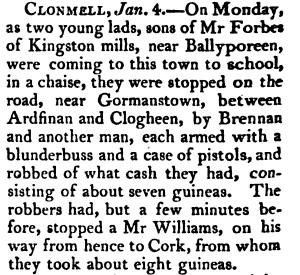
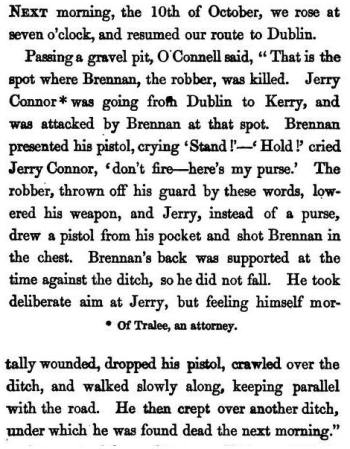

![5. "Bold Brannan On The Moor", broadside, date & printer unknown, from: [An Album Of Street Literature], n. d., p. 294 5. "Bold Brannan On The Moor", broadside, date & printer unknown, from: [An Album Of Street Literature], n. d., p. 294](../assets/images/Broadside-Brennan.jpg)
